Mountain biking is having a big moment right now. New riders have been hitting the trails in droves and we are over the moon that they are discovering the freedom, exhilaration, and connection with nature (and each other!) that mountain biking provides. So, let us start by saying:
Welcome to the mountain biking community!
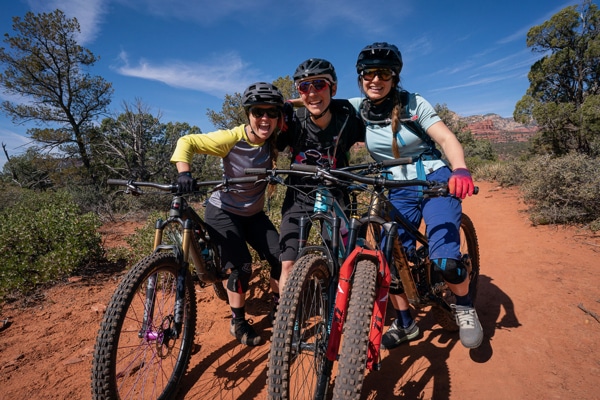
Disclaimer: these rules aren’t meant to be a bummer. Knowing the ropes will boost your experience by keeping your time on the trail positive, you’ll be more confident about how to conduct yourself, and the community as a whole will be better for it!
1. Say Hello
Offer a friendly “hello” “howdy” or “what a FANTASTIC day!” to people you see on the trail. Give extra warning if you’re approaching someone from behind to avoid startling them and give them time to find a safe spot to let you by. If you see someone stopped and off of their bike, just ask to make sure they’re okay. If they’re lost, have a mechanical issue or are picking themselves up after a wreck, you might be able to lend them a hand.
2. Right-of-Way

Mountain bikers yield to horses and hikers. Bonus points for getting off of your bike and speaking calmly to horses as they go by.
Other mountain bikers: Unless otherwise noted, if you’re riding downhill, you yield to those riding uphill. If you stop, move yourself and your bike off the trail to make way for other riders.
3. Ride Open Trails
Sometimes trails have to be closed due to wet conditions, trail work, or safety issues and it’s important to respect those closures. If you’re not sure, check with the trail advocacy group or land manager. Some trails do not allow mountain bikes including state and federal wilderness areas.
4. Pack it in, Pack it out
Never leave trash on the trail. Better yet, pick up any trash you spot!
5. Stay in Control
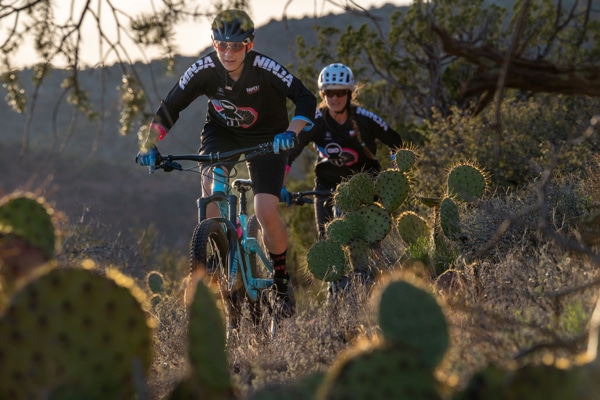
Ride within your limits and be extra vigilant when it comes to blind corners and sections with limited line of sight. These are sketchy spots for collisions and the most frequent place that user conflicts occur.
6. Turn it Down
Yes, your favorite jams can add a little pep to your pedals on a long climb and get you flowing on a ripping decent, but either take one headphone out or turn the volume down enough that you can hear other trail users (and wildlife!).
7. Don’t Skid
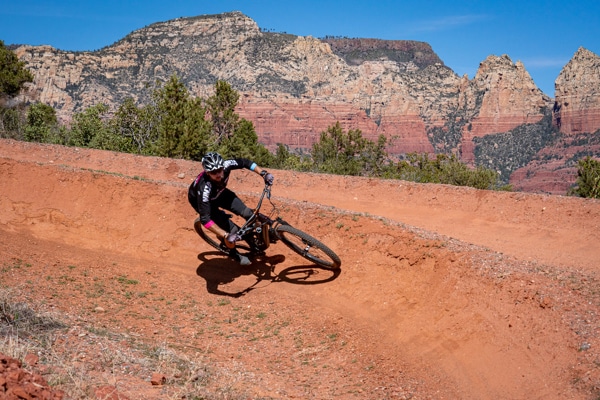
This might come as a surprise to anyone who’s ever watched a mountain biking video, but skidding is bad news. Not only does it destroy/erode/widen the trail, it also means you’re out of control (see rule #5). Check out our Braking 101 article to learn about “easing the squeeze” and braking like a boss!
8. Sharing is Caring
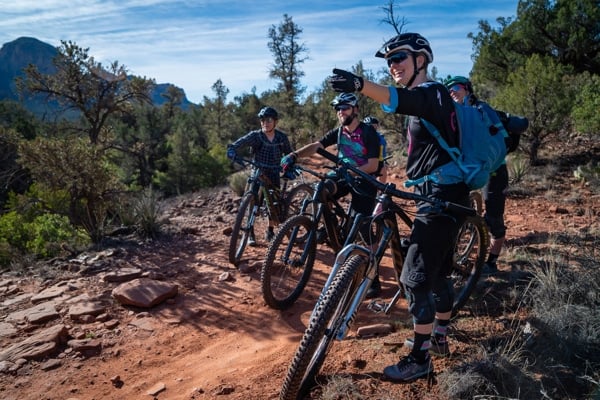
Share these basic rules with your friends, family, and kids and don’t be afraid to (kindly) mention them to a fellow trail-user (who’s not a stranger because you’ve just waved and said hello!). Staying on positive terms with other trail users will allow mountain bikers to maintain and even improve access to our favorite riding areas.
Extra Credit
Head to Trailforks to find a trail near you, scroll down to “Local Trail Organization” and voila! Those are the generous souls that build, maintain and advocate for the trails you ride. Become a member, sign up for their newsletter, follow them on social media, and, most importantly, stay in the loop on all the different ways you can get involved. Happy trails!
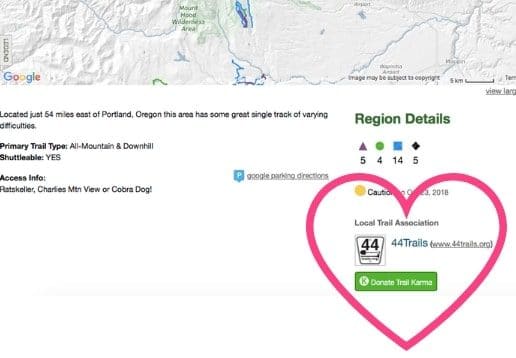

This is an important topic but I think it missed some really important points. Points such as “ride on the most durable surfaces”. Not on the moss on the rocks at DuPont. Where to ride on the trail and what to do if you can’t ride a feature. A big issue in our area is becoming trails widening from 2 feet wide up to 15 feet wide in some areas due to riders making their own lines around technical sections rather than walking through them. It is very important for riders to walk the center of trails they can’t ride. That being said, I think our goals really should be to ride in the middle of the trail. That’s where all of the good technical shit usually happens anyway. The other issue is mud puddles. In The Pisgah where I ride and teach, the appropriate place to ride mud puddles is right through the middle. Many of the same 2ft to 15ft issues are happening due to mud puddles. Good start but I would like to see more of this and more in depth articles about how Leave No Trace can be practiced by the mountain bike community. This is THE most important thing our user groups need to be educated on. Our trail longevity and trail access depends on it.
Thank you for bringing up the point. I have seen small marsh areas being widened by bikes trying to avoid mud.
Just one comment: skidding does not necessarily mean you are out of control. Racers skid all the time to tighten the radius of their turns so they can hold more speed through it. That being said, those trails are also maintained before and after every event, and by no means should everybody start doing it. It does cause significant erosion.
Great article. Saying hi and being friendly used to be commonplace in the early days but seems more and more less frequent.
One point of asking, though – and I am open to feedback, is the yielding to uphill riders. When you’re finally enjoying the reward of a hard climb on a predominately downhill route and come across someone wanting to at temp it uphill, I feel the uphill rider can easily move aside and let the downhill person enjoy the flow. When I’m riding uphill I always give way to the downhiller so they can have their fun. Think of the guy riding Rocket or Meadows in Aliso, come on, let the downhillers enjoy the ride, it’s easy for the uphuller to step off for a few seconds. Think if it were you enjoying the downhill to have to stop for an someone riding oppo.
Just my opinion. Open to feedback.
Thanks for the comment, SoCal. Sometimes I miss the friendly greetings, too, but that won’s stop me from doing my part to share the stoke by smiling and saying hi to every single person I see. Let’s hold strong 🙂
As for your thoughts on yielding, I think it’s important that everyone knows exactly what’s expected out on the trails – in this case, the rider coming downhill pulling to the side to let the climber continue uphill. That being said, exceptions can be made BUT only by the person with the right-of-way. As the climber, you can yield your right-of-way to let the downhill-er maintain their flow on the descent, you just cannot expect others to do the same for you. As always, clear (and kind) communication is key.
Spot on! … except, If etiquette is going to work It shouldn’t come down to rider judgement. Ride like there are others on the trail. Pull over, make a friend, its really gratifying.
Another perspective on yielding: The slower uphill rider has an unknown level of fitness and skill, meaning they may not be able to mount their bike and continue if they stop mid-ascent. The downhill rider, assuming the same level of fitness and skill, will have an easier time continuing downhill. The lesser of two evils: losing your precious “flow” or losing your ability to clean a climb. The latter hurts my soul a little more, as does preventing someone else from enjoying the accomplishment of a hard-earned climb. Just my opinion of course, which is worth the virtual paper on which it’s printed, although IMBA tends to agree.
Ninja agrees – – the uphill rider always has the right of way, unless the trail network where you are riding specifically noted otherwise on their trail rules!
100% Agree. What is the logic for the fastest person with the most momentum having to slam on their brakes for someone going much slower uphill? I say this as the person going up hill as well. It feels so un-natural to make the person bombing down at you stop so you can crawl by them. The person going up hill can almost always hear the person coming down and move out of the way far in advance of the person going down, who can’t hear anything other than their own motion. Anyone know what the thought process is to this “rule”?
A big part of it is where you are looking when you desend vs climb. When desend you are looking further down the trail. When climbing, especially on a technical climb you are looking at the trail directly in front of you. Uphill riders may not see you in time to yield. Additionally, the faster rider has the most potential energy. If the uphill riders yields and the down hill rider makes no effort to slow down, and something goes wrong (uphill rider can’t get far enough off the trail) it is the speed of the down hill rider that will cause the damage.
As a trail user who mountain bikes and hikes, I always appreciate it when the first biker approaching, me going the other way, indicates how many other riders are behind him or her. The mountain biker saying, “two more”, lets me know that I can expect two other riders behind him. This is especially helpful on more narrow trails.
spot on, it’s polite and informs the other trail user. They then know what to expect and can remain cool and happy that us mtb ers are considerate and not a bunch of adrenaline fueled twats.
I also use my very friendly cling…clongggg bell in areas that are fast and where their may be other trail users that I cannot see.
Easy isn’t it???!?
As far as hikers go… I find it rare when I slow down and greet them they don’t move off the trail and let me pass. Very rare for them not to. I must not live in the area of the country where the hikers are out to get the mountain bikers. hehe
Great article. Just one point for clarification, this applies to hikers too which is where I learned it.
When you pull over to let a horse pass, pull over on the lower side of the trail, as if you’re on the higher side, your could be taller than the horse and be seen as a threat, and the horse could become unpredictable. Rare but it can happen.
Excellent points and I do them all. IMBA teaches this also in it’s BICP course.
One item to add is that the uphill rider has the right of way on two direction trails.
Yield to a rider that’s climbing and be aware of riders that might need a little more room because their bike handling skills are not quite dialed in yet.
I would suggest adding pull off to the right when yielding or stopping for another rider.
Thank you for sharing this important information